July 25, 2020, by Kathryn Steenson
Agricultural Societies
Many agricultural societies were formed during the 18th century at a local level, enabling like-minded farmers to meet on both a professional and social level. The general aim was to share information on the latest farming methods and to improve livestock breeding. References to these societies can be found amongst the family and estate papers held in Manuscripts and Special Collections. Several prominent Nottinghamshire landowners, such as the Duke of Newcastle at Clumber House and Viscount Galway at Serlby Hall, became patrons or governors and it must have been with some pride that a society could count a peer as one of its members and add his name to their letterheads.
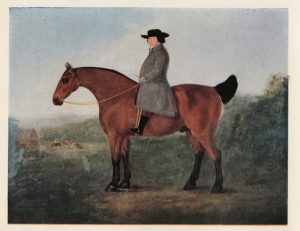
Robert Bakewell, founder of the Dishley Sheep Society. From Robert Bakewell Pioneer Livestock Breeder by H. Cecil Pawson, 1957. East Midlands Collection
Leicester agriculturalist Robert Bakewell ( 1725-1795) was an important figure in the British Agricultural Revolution. He was one of the pioneers of systematic selective breeding of livestock, especially sheep and cattle, and novel methods to improve grazing. As the founder of the Dishley Sheep Society in 1783, he was able to teach his ideas and methods to his contemporaries.
The Society was established to preserve purity of breed and acquired its profits from the sale of stock and the ‘letting’ of rams. It followed a strict code of conduct, with its rules and resolutions being drawn up in meetings held at inns in Leicester and Loughborough. Resolution No.4 obliges members to keep the content of their meetings confidential and demands “that secresy [sic] be kept by all the members respecting the business of these meetings except to the members absent, and that any member quitting the society keep secret upon his honour the transactions before he left it”.
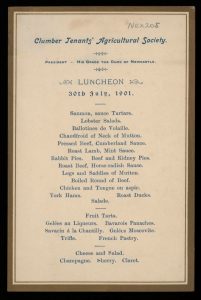
Printed menu from the luncheon of the ‘Clumber Tenants’ Agricultural
Society’, 30 August 1901
Ref: Ne X 205
The networking side of such clubs was also very important to members, and as you might expect, they ate very well at the social events. The menu shows an enormous array of hot and cold dishes, plus desserts, and an appropriately broad selection of alcohol to wash them all down with.
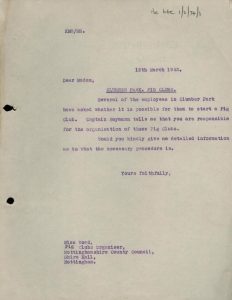
Letter from K. Murray Walker to Nottinghamshire County Council, 12 March 1942 (left), and reply from the Nottinghamshire War Agricultural Executive Committee, 13 March 1942 (right).
Ref: Ne 6 EC 1/2/74/1- 2
One way of supplementing meat rations during the Second World War was to form a ‘Pig Club’. At the Duke of Newcastle’s Clumber estate, employees formed a cooperative club which obliged them to sell some of the meat they produced to the Ministry of Food. Regulations stated that the maximum number of pigs which could be kept by a club at any one time should not exceed a ratio of 4 pigs per member.
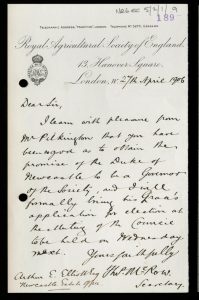
Letter from Mr McRow, secretary of the Royal Agricultural Society of England,
to the Newcastle Estate Office [Clumber Park], 27 April 1906
Ref: Ne 6 EC 5/2/1/9
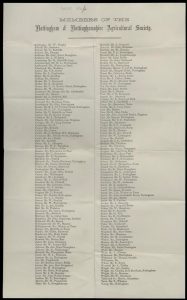
Printed list of enrolled members of the Nottingham and Nottinghamshire Agricultural Society, by name and place of residence, 19th century.
Ref: Ga 2 E 25/2
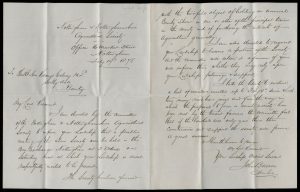
Letter from John Barron, Secretary of Nottingham and Nottinghamshire Agricultural
Society to George Edmund Milnes Monckton-Arundell, 7th Viscount Galway, 19 February
1878, together with a list of members.
Ref: Ga 2E 25/1-2
In this letter Mr Barron explains to Viscount Galway that “the [Nottingham and Nottinghamshire Agricultural] Society has been formed with the twofold object of holding an annual County Show in one or other of the principal towns in the county and of furthering the interests of agriculture generally”, and enclosed this rather impressive list of members.
The University of Nottingham collects archival material relating to the history of the University and its predecessors, including the Midland Agricultural and Dairy College, and the history of the East Midlands. These items are just a few from the collections held at Manuscripts & Special Collections at Kings Meadow Campus. The Reading Room at Kings Meadow Campus is currently closed due to Coronavirus, but we are running a limited enquiry and reprographics service. For more information, see www.nottingham.ac.uk/mss or email mss-library@nottingham.ac.uk
No comments yet, fill out a comment to be the first

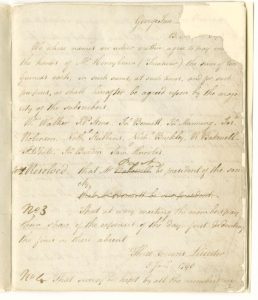
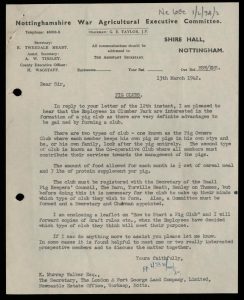
Leave a Reply